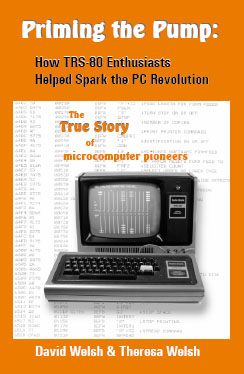Priming the Pump: How TRS-80 Microcomputer Enthusiasts Helped Spark the PC Revolution
355 pages, with full Index and over 100 illustrations
Paperback Edition. ISBN 0780979346804
Only $19.95
This is the first book to capture the unique era of the late 1970s and early 1980s, when personal computing was just getting started. David and Theresa Welsh were part of the community of small software entrepreneurs and personally knew many of the principle players whose accomplishments are the stuff of legends.
Some of What’s in this One-of-a-Kind Book:
|
a.
|
Steve Leininger, hired away from Silicon Valley by Tandy Corp., worked alone amid the grimy surroundings of an old Fort Worth saddle factory and built the prototype TRS-80; the final development cost was less than $150,000.
|
|
b.
|
John Roach, Tandy’s product manager, got an agreement from Charles Tandy to build 3500 units after Leininger demonstrated the prototype; this was exactly the number of stores they had — Roach figured if no one bought the computers, at least the stores could use them. Don French, a true believer, predicted they’d sell 50,000 the first year and urged the company to gear up the factory for mass production. Tandy managers, thinking they could never sell that many, were surprised when, in the weeks after the introduction, the Tandy switchboard was paralyzed with over 15,000 calls from people wanting to order a TRS-80. In the first year, over 250,000 people went on waiting lists to buy a TRS-80!
|
|
c.
|
Tandy contracted with Randy Cook to create a Disk Operating System (TRSDOS) for the TRS-80 Model I and III, which would support floppy disk drives. The company agreed Cook would retain ownership of the code. But Cook, believing Tandy violated the agreement, created a rival DOS which he sold through his own company. Tandy managers found Cooks’ name embedded in the TRSDOS code.
|
|
d.
|
TRSDOS replacements appeared – five of them – and programmers made up their own homespun magazine ads touting their products great features and attacking their rivals’ products in the pages of magazines like 80 Micro, the most popular of many publications devoted to the TRS-80. e.g. Wayne Green, publisher of popular computer magazines, promised to “editorially break” Radio Shack because they would not carry his 80 Micro magazine in their stores; his magazine column often lambasted Radio Shack CEO John Roach.
|
|
e.
|
Bill Schroeder, a successful businessman, bankrolled Logical Systems, Inc. and sold Tandy on LDOS as the company-sponsored TRSDOS replacement. A state-of-the-art headquarters and good money followed the lucrative contract, but once he sensed the coming demise of the TRS-80, Schroeder simply shut down his company.
|
|
f.
|
Scott Adams created popular Adventure games for the TRS-80 and other early microcomputers, became a celebrity in the magazines, but produced too many game cartridges for a computer that died in the marketplace.
|
|
g.
|
Along with microcomputers, home robots were hot. Meet the robots of the 1980s – and the man who said we were all going to have mechanical men in our homes by the year 2000. Unlike microcomputers, robots just didn’t catch on.
|
|
h.
|
A notorious scam artist preyed on the gullibility of microcomputer enthusiasts, destroying the Southern California Computer Society with a Ponzi scheme, then bilking TRS-80 owners out of thousands of dollars with magazine ads from a bogus company called World Power Systems showing phony products.
|
Here is the real story of the first microcomputers, based on the Welsh’s personal experiences selling TRS-80 software and our interviews with amazing microcomputer pioneers.
Visit the book website to read excerpts.
At present, the book is available only from the Welsh’s, but it will be listed on amazon.com in the coming few weeks.
|

![[Model I]](../../../../images/computer-model1bx150.png)